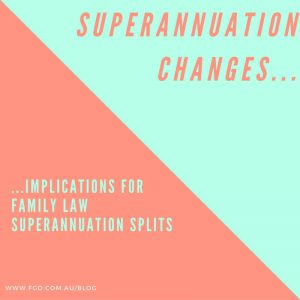
In an earlier blog I wrote about how the proposed changes to superannuation will impact on estate planning. Now let’s see how they may apply to Family Law superannuation splits.
You will recall that one of the proposed changes is the imposition from 1 July 2017 of a transfer balance cap of $1.6 million on pension accounts.
This cap is indexed going forward and will prevent people commencing any tax free pension account in excess of the transfer balance cap. The cap is a lifetime cap so it cannot be added to except in very limited circumstances.
This poses a challenge for parties going through a family law separation. What are the implications for a member who under a splitting order is required to split their superannuation in favour of their former spouse? Will their cap be reduced? What about for the non-member spouse? Will the amount split in their favour be credited against their own balance? Would they be required to commute part of their own pension if the combined amount exceeds the transfer balance cap?
If the member is not in receipt of a pension then the changes will have no impact as the transfer balance cap does not apply until the pension is commenced.
If the member is in receipt of a pension then the following will occur:
- If the underlying interest in the fund can be split (this applies to most funds except for some defined benefit schemes) and the pension account of the member is partially commuted so that the amount can be transferred to the superannuation fund of the non member, the member will be entitled to a credit for the amount transferred.
- If the underlying interest in the fund cannot be split then the non-member will only be entitled to each individual payment split. However the member will have a debit applied to their transfer balance cap equal to the total amount of the split. The non-member’s transfer balance cap will be credited with the total value of the income stream supporting the pension. The non-member then is entitled to a replenishment debit for the balance of the member’s remaining pension to reflect the actual benefit received.
- If the interest of the member is subject to payment splits but can later be commuted (for example, the scheme allows the benefit to be commuted after the member turns 65) then both the member and non-member will be receive a debit for the value of the lump sum received in the transfer balance.
The above might make more sense with an example.
Brad and Angelina are members of the Brangelina Industries fund. Brad is retired and has a pension account holding $1.6 million. A 60% splitting order is made over the interest of Brad in the fund. Brad’s transfer balance cap is $1.6 million. Angelina has not retired yet so does not have a transfer balance cap.
Situation 1
The super fund partially commutes Brad’s pension by $960,000 and transfers this amount to Angelina’s interest in the fund. Brad’s transfer balance cap is debited by $960,000. His transfer balance is now $640,000 meaning he could top up his pension account up to the value of the $1.6 million cap. As Angelina has not commenced a pension her transfer balance cap remains $0.
Situation 2
The super fund splits each monthly pension payment of $10,000 from Brad to Angelina such that Angelina receives a payment of $6,000 while Brad receives $4,000. A debit for the value of the split of $960,000 applied against Brad’s transfer balance of reducing it to $640,000 meaning he can contribute a further $960,000 to his pension account.
As Angelina is now in receipt of a pension her transfer balance account is credited with the value of Brad’s pension account of $1.6 million (as it is supporting the pension to which she is entitled) meaning that she has hit her transfer balance cap.
The transfer balance account however is debited by the value of a replenishment debit equal to the $640,000 remaining in Bradley’s pension account reducing her transfer balance to $960,000.
This pension entitlement that Angelina is receiving is not subject to the age limits that normally apply to commencing a pension however she will not be able to top up the pension account with additional funds until she has satisfied a condition of release in her own right.
Situation 3
10 years after situation 2 commences Brad is able to commute his pension and elects to do so. The $1.6 million has now reduced to $1.2 million. Angie receives 60% of the commuted lump sum of $720,000 while Brad receives the balance of $480,000.
Brad will receive a debit of $480,000 on his transfer balance account meaning his transfer balance account is now $160,000. Angelina will receive a debit for the $720,000 she receives reducing her transfer balance to $240,000. Brad will be able start a new pension based on his transfer balance cap of $1,440,000 while Angelina will be able to start a new pension of her own based on her transfer balance cap of $1,360,000.
Careful consideration will now need to be given by parties going through a family law separation how to structure the settlement and any splitting orders taking into account the above added complexity.
There are some additional factors to consider where a defined benefit is involved which I will cover in a future blog post.

Paul Salinas is a Family Lawyer and Superannuation Expert at Farrar Gesini Dunn, Canberra Office.